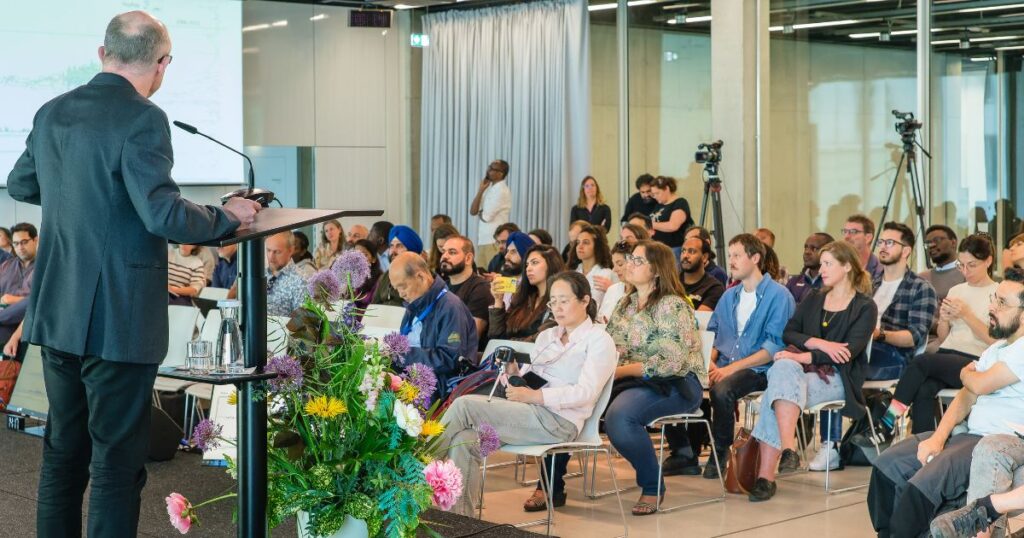
In the 10 Years of Global Innovation Gathering Conference, Peter Troxler engaged in a dynamic conversation defining distributed manufacturing in the 21st century and what the future of it might look like. To answer the question of what distributive manufacturing is, one must look at the history of open source hardware.
The year 1993 marked the year of the first documented open source community in modern times through TAPR Radio Amateur – although there were other sources done before 1993 up until most of them became patented. An exemplary embodiment of what the modern open-source movement resembles is evident in the Bang & Olufsen speakers introduced in the 1970s.
Bang & Olufsen made a significant impact on the audio industry by introducing wireless capabilities, revolutionizing the way speakers were used. Prior to this innovation, speakers were typically connected to audio sources through wires, limiting their mobility and placement options. Bang & Olufsen transformed this traditional setup by developing a wireless transmission system for their speakers. They employed advanced technologies, such as infrared or radio frequency, to transmit audio signals wirelessly from the audio source to the speakers. This breakthrough allowed users to place the speakers anywhere within range without the constraint of physical cables.
You can see such examples of open source in other areas such as the White Rabbit project by CERN and DIN SPEC as we try to understand better the vocabulary of open source.
Pressing forward while looking at the history, one needs to evaluate the progression of open source. Peter does so by speaking on three relevant issues related to open-source hardware. Troxler points out that distributed manufacturing presents unique challenges due to different manufacturing entities’ diverse environments, knowledge, capabilities, and capacities.
When shifting from centralized to distributed production, there is a wide range of industrial and manual capacities to consider, along with variations in standards and quality. An analogy to the 2012 Open Knowledge Festival in Helsinki highlights similar challenges regarding materials, including availability, standards, and circularity.
Distributive manufacturing has been extensively studied, with comparisons made between centralized and decentralized approaches. Open-source hardware communities often fork projects due to factors like engineers’ “not invented here” mentality and the need for localization to address specific local requirements. However, organizing federated learning across these diverse entities remains a significant challenge, such as enabling knowledge sharing and collaboration when one group discovers a clever solution that could benefit others.
As we look at the progress made with open source hardware the research findings reveal several key points regarding distributed manufacturing. Firstly, it emphasizes the shift from linear value creation to circular production, connecting it to discussions on repair and the importance of value preservation. Secondly, Traditional supply chains are being transformed into open hardware entrepreneurs who view both the supply and customer sides as a community. Thirdly, network manufacturing involves considering the local entanglement of networks rather than a centralized approach, highlighting the significance of localized contexts.
The research also highlights the emergence of open house initiatives, such as 3D printing and wiki houses, as important contributors to distributed manufacturing. Furthermore, the findings observe that distributed manufacturing tends to rapidly emerge during moments of crisis (i.e. Covid Masks) but can collapse quickly if key resources such as materials, time, people, and personal energy become scarce.
Considerations for designing in the context of distributed manufacturing involve addressing the potential collapse of resources and adopting a theoretical approach to design. Buchanan’s design research and learning work provides a framework that moves from low to high complexity. This framework and distributive manufacturing “encourages designers to go beyond simply creating symbols or products and instead focuses on designing interactions, systems, and systems of systems”; it emphasizes the importance of considering things, experiences, and transformations.
Buchanan’s holistic approach combines the interconnected elements of symbols, products, interactions, systems, values systems, localized entanglement, and the design of global manufacturing paradigms. By considering these considerations, designers can effectively navigate the challenges and complexities associated with distributed manufacturing in the 21st century.
Show Notes & Supplementary Notes: Mentioned in this Talk
3:22 – 3:24
Glass making in England:
https://the-past.com/feature/glass-roots-examining-the-archaeology-of-glassmaking-in-england/
Write Brothers about the Airplane:
https://www.dpma.de/english/our_office/publications/milestones/airandspacepioneers/wright/index.html
PDP – 10:
https://en.wikipedia.org/wiki/PDP-10
3:36
Covid 19 Masks:
(PDF) Distributed Manufacturing of Open-Source Medical Hardware for Pandemics
https://www.sciencedirect.com/science/article/pii/S2772369021000128
Get a deeper view of how this talk went during the conference in Berlin through the video below.

